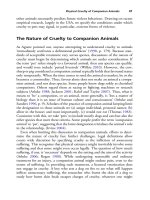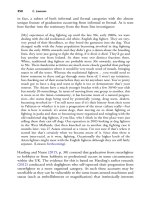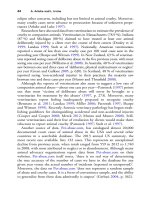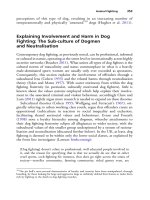The palgrave international handbook of a 156
Bạn đang xem bản rút gọn của tài liệu. Xem và tải ngay bản đầy đủ của tài liệu tại đây (37.31 KB, 1 trang )
Status Dogs
147
around links between status dog and the more serious criminal activities,
including dog fighting and gangs.
By employing alternative methodologies Raghavan et al. (2013) appear to
offer some evidence that BSL can reduce the incidence of dog bites, particularly bites on young people, however they do not examine in detail other
contributing factors, such as a heightened public awareness—even a moral
panic—which could itself cut opportunities for attacks. Success in terms of
reducing dog bites may more likely be in the form of interventions through
enforcement. Clarke and Fraser (2013) found that rather than BSL having
any measurable effect, it was control notices or ‘ticketing’ issued by the local
municipal authority that provided encouraging results. BSL penalises the
dogs (covered in the legislation) and also responsible owners of those dogs for
unproven potentially dangerous behaviour. If pre-emptive measures are to be
utilised, better these centre around owners who have been identified as
irresponsible or likely to misuse their dogs as this will also benefit ‘the dogs
themselves if it prevents them from being kept in situations contrary to good
welfare’ (Dobson 2011, p. 1). While the dog pays the ultimate price with its
life, their owner is free to repeat these mistakes if they acquire a new dog,
especially if the causes of the attack are not examined and addressed. Society
rarely holds parents responsible for a dog attack on a child within the home,
although there are increasing calls for alternative educational strategies which
will require parental identification of the factors that led to an attack
(Mannion et al. 2015). Furthermore, BSL could inadvertently be contributing to dog attacks and bites by falsely reassuring owners of non-prohibited
breeds that their dog is not capable of being dangerous.
The prohibition of certain breeds has directly increased the allure of
behaviourally similar, but marginally physically dissimilar breeds, in order
to circumvent legislation. In addition to the direct consequences to the four
banned breeds, there are clearly other substitute social harms arising from the
DDA 1991 (Lawson forthcoming) such as the effect to these comparable
breeds. Other measures have sought to address human behaviour, for example, the mandatory microchipping of dogs12 provides a legal link between
dog and owner. Other developments such as new dog breeding legislation13
12
As previously stated, legislation has been passed by the UK Government for England (2015), the
Welsh Government (2015) and Scottish Government (2016), all in force for April 2016. Northern
Ireland has retained a dog licensing scheme which includes mandatory microchipping.
13
Animal Welfare (Breeding of Dogs)(Wales) 2014 were passed by the Welsh Government and came
into force in 2015. This is the first legislation in the UK which requires socialisation, enrichment and
enhancement measures at licensed dog breeding establishments.









